
The Award Winning
Monthly Newsletter of the Anchorage Coin Club
Volume 13, Number 6 June, 2000
June Membership Meeting:
Wednesday June 7th , 2000 Central Lutheran Church 7:00 open, 7:30 PM Meeting

"What's So Great About Eary Gold?"
FROM YOUR EDITORS
The YN Donation Auction, designed to raise money for the numismatic education of our young members, was a success! Books, coins, and other numismatic items, donated to the club, were auctioned off at the May 3rd meeting. We started the meeting with the lots (91 of them) laid out on tables for everyone to view. But before we started the auction we had some drawings: the door prize, a 1986-S Proof Kennedy Half Dollar, was won by Roy Brown and the membership prize, a giant 3 oz. Proof Silver Medallion from the Alaska Mint, was won by John Larson. Then the raffle prize, a nicely toned 1893 Barber Quarter NGC graded AU58, was, after stiff competition, won by Bill D’Atri.
Then Larry started auctioning off coins, books, sets, medallions, gold, a lens, and everything else a numismatist would find attractive and he didn’t stop until we had sold all 91 lots. When the dust cleared we had raised $755.25 for the Young Numismatists Program - a good sum.
Sarah Bilak will need some of that money this summer; we are sending her to the ANA Summer Conference in Colorado Springs July 8-14. There, she will meet coin people, and have fun doing coin things (I hear they have access to a steam driven coin press), and possibly come back with same appreciation for numismatics that us old folks have.
This summer our annual picnic will be at Centennial Park on July 23rd. As usual it will be a potluck with the club providing burgers, dogs, chips, and sodas. Just bring yourself and loved ones and a salad or dessert and have fun.
Having indoor meetings in the summer is not a popular thing to do, so
we are getting out of touch with each other about new (old) coin finds.
But people travel a lot in the summer and we hope you bring back many treasures……Your
Editors.
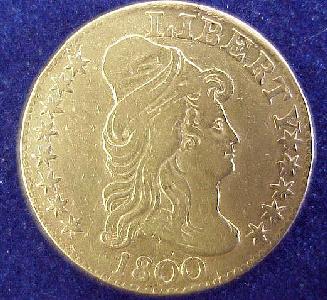 |
MEMBERSHIP NEWS
Schedule of Events for the Month of June
The Board meeting was called to order at 7:00 PM by club president Bill Hamilton.
Correspondence and bills were first reviewed by the Board.
The meeting was largely dominated by planning for the Anchorage Coin Club summer picnic scheduled for July 23rd, Sunday afternoon (12 noon to whenever), at Centennial Park in Anchorage. This will be a potluck party with members bringing desserts, salads, and whatever they desire. The club will provide for the basic necessities including hotdogs and hamburgers. Club members, their families, and guests are welcomed to this event.
The July 23rd summer picnic will also be our club’s regular membership meeting date. This is in keeping with our club’s tradition. There will be events scheduled for the summer picnic and door prizes to be given away.
The club schedules for the months of June, July, and August were then reviewed.
The June 7th membership meeting will see a presentation by club member, Bill D’Atri, on the subject of “Morgan Dollars and VAM Varieties”. Two days later (June 9th) will see our YN meeting with Larry Nakata giving a presentation of a subject on “Foreign Coins”.
As stated earlier, July 23rd will see our coin club’s summer picnic/membership meeting at Centennial Park.
No subject has been determined, as yet, for our August 2nd membership meeting. There will be no YN meeting held in the month of August. However, YNs are still encouraged to come to the August 2nd membership meeting.
The remainder of the meeting was mostly talk about coins.
The Board meeting concluded at 8 PM.
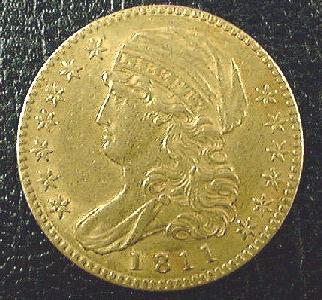 |
Our YN meeting on May 12th saw a very good turnout of YNs and parents. The session that evening was on the subject of “Alaskan Tokens”.
This particular subject was chosen to give our YNs a bit of Alaskan history.
The Alaska gold rush around the turn of the 20th century saw a necessity for use of trade tokens. With the scarcity of US coins and currency in Alaska at that time, such tokens were honored by the local store or merchant. Since such tokens stayed in that community, this provided a degree of economic stability for that region.
The session then went over various types of Alaskan trade tokens from various communities around Alaska. The most famous Alaskan trade tokens are the ARRC (Alaska Rural Rehabilitation Corp) tokens of 1935…..also called “bingles”. In May/1935, as a result of the U.S. economic depression, the federal government relocated about 200 families from the U.S. Midwest to Palmer, Alaska. These families were given land and jobs to help build a farming community in Palmer, Alaska. These ARRC tokens were distributed as payment to the farmers for their work and could only be used at the federal government commissary or an ARRC operated store. However, other private businesses soon accepted these tokens in trade. By 1936, these tokens were discontinued and replaced with U.S. coinage and currency. Trade tokens slowly died away as more and more U.S. coinage and currency circulated in Alaska. With the coming of statehood in 1959, the need for such trade tokens went away.
Alaskan tokens today are essentially commemorative tokens or medallions used to commemorate an event, such as the numerous statehood medallions in 1959 or the Alaska Mint’s medallions today.
Alaskan tokens are thus divided into two categories:
The winner of the YN membership prize, a U.S. 1976 Bicentennial 3 coin silver proof set, was YN Kiersten Hackley.
Our next YN meeting will be on Friday, June 9th at the Central Lutheran Church (same time 7 PM). I will be covering a subject on “Foreign Coins”.
Hope to see a lot of YNs and their parents at the June 9th meeting.
Also…don’t forget about our club’s membership meeting on June 7th. YNs
are welcome to come to the membership meeting as well……Larry Nakata.
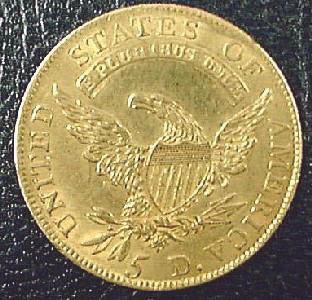 |
“WHAT’S SO GREAT ABOUT EARLY GOLD?” by Mike Nourse (Member # 94)
First of all, for our newer readers, we should examine what exactly is meant by early gold. Of course, I am referring to early federal United States gold coins….not the really, really old Greek or Roman gold. I will leave that subject for our fearless leader, Loren Lucason, who is an expert on ancients. But here we are specifically focusing on the gold coins produced in the U.S. between 1795 and early 1834.
During those first forty years of gold coin production, only three denominations were actually struck for circulation: the quarter eagles ($2.50), half eagles ($5), and eagles ($10). Early Americans would have to wait another 15 to 20 years before the U.S. Mint would begin producing to gold dollars, $3 pieces, and double eagles ($20).
So what is so great about these coins that were made seven generations ago? Well, first, they are gold coins, and any gold coin attracts attention. Even with the price of gold bullion steadily declining for the last twenty years and showing no sign of heading back upward, people are still buying , selling, trading, and investing in gold coins in huge quantities.
Another factor in their popularity is the design. A total of three designs were used during the 40 years from 1795 to 1834. Two of these designs are only available on these early gold coins and were never used on any copper, nickel, or silver coinage. For type collectors who wish to obtain one coin of each design, there is no other way to get the capped bust to right (turban head) or capped head to left designs. Only the capped bust to left design may be found elsewhere, specifically on silver half dimes, dimes, quarters, and half dollars. The design is not identical on the silver coins compared to the capped head to left gold coins, but it is fairly close. The only real difference is that on the gold coins, Liberty’s cap is somewhat larger and therefore flops over the back of her head.
The third and probably most important reason that these coins are so very popular is their scarcity. This scarcity comes from two sources: a small original supply and a great deal of melting. As for the supply side of the equation, a total of approximately 2,316,000 gold coins were struck between 1795 and early 1834 broken down as follows: 64,000 quarter eagles; 2,120,000 half eagles: and 132,00 eagles. Do not accept these mintages as gospel as mint records from that era are somewhat unreliable but they do give us a general idea of how many of these coins were produced. Besides, the number of these coins originally produced, while it is a small number, only tells us a small part of the story.
The other part of the scarcity story is more important than the tiny production numbers. It has to do with the huge amount of melting that occurred right from the start of the 1790’s on through about the 1850’s. During the years they were being made, many were used in trade with Europe where they were melted down. Here in the USA these coins did not circulate very much as the public seemed to prefer to use French, Portuguese, Spanish, Mexican, and other foreign gold coins.
During the 1820’s and 1830’s, silver mines in Mexico and Peru cranked out vast quantities of silver which resulted in gold becoming more valuable in relation to silver. The obvious result is that the gold coins had to have their weight reduced to bring their bullion value ($5.33) back in line with their face value of $5.00. After the weight reduction went into effect in June 1834 and a new design was introduced, all of the older heavier coins went straight to the melting pot. A few pieces were saved as mementos and heirlooms but all the rest were melted down either at the mint or privately. When it was all over, about 99 percent of the original mintage was gone forever.
Now, all of a sudden, our original mintage of 2,316,000 for all gold coins of 1795 through 1834 has been reduced to roughly 23,000 survivors. And remember that these 23,000 survivors are not for one issue but are spread among over 70 different issues in three denominations! With that few coins available, less than one person in 10,000 in the United States can possibly own an early gold coin.
However, we are not done yet with trying to figure out how many early gold coins are actually available. Of the survivors it is likely that at least a thousand or more are permanently impounded in various museums around the world. So now that the museum coins are out of the picture we are left with the coins that sit in private collections and dealers inventories. The bad news is that an awful lot of these coins are defective. This can range anywhere from a harsh “scrub a dub dub” to heavy damage such as holes, bending, attempted repair, and almost any other form of abuse that has been thought of in the last two centuries. From my own observation, of many fixed price lists and hundreds of auction catalogs in my library I would estimate that half of the survivors have some form of defect. So now we are down to maybe 10,000 decent early gold coins.
So, when it comes to early gold, is there any good news while we discussing
availability? Actually, there is. And that good news is in the area of
condition. As I mentioned before, most of the coins that did survive the
last 165 plus years were set aside as curiosities, or given as gifts, or
stored in some early bank. Therefore it was generally new or lightly circulated
specimens that are here today in the 21st century. The vast majority range
from Very Fine to lower Mint state condition. Very few had time to wear
down to Fine or lower condition before they all disappeared from circulation
in 1834. People in that year probably did not bother to save worn out specimens
– they just turned them in to be melted. Most people are actually quite
surprised to find out that so many of these old coins remain in Uncirculated
condition.
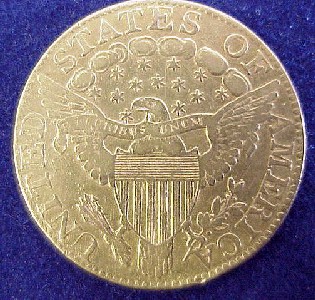 |
And if you want one of these old gold coins to find a place in your collection, how much will it cost? As you have probably already figured out, they are very expensive. For some of the most common dates of early half eagles you will have to part with at least $1500 to get an unimpaired coin in Very Fine. In better states of preservation you should plan on a minimum of $1900 for EF, $3200 for AU, $5000 for MS-60, and $11,000 plus for a MS-63. On the bottom end, I have seen harshly cleaned or severely worn early gold coins selling in the $850 to $975 range. Totally wrecked coins can be found in the $400 to $475 area but you can expect a fairly unattractive item.
There is an excellent case to make for buying a slabbed coin rather than a raw one. First and foremost you do not want to shell out a fortune for a coin that eventually turns out to be a fake. Also, these pieces were all struck in a hand press so strikes are often weak making grading quite a challenge. Few people other than workers at the professional grading services get to see enough of these to know all of their characteristics. For those collectors that do not put slabs in their collections it is an easy task to remove the coin from the slab.
Now the only question left is how does a collector go about forming a collection of these early gold coins? Well, realistically, you don’t. That is probably not the answer that you expected, but due to their expense and rarity there is just no way that you can form much of a collection in this arena on a normal budget. Most people are happy to have a single specimen of pre-1834 U.S. gold.
For more adventurous (not to mention wealthy) collectors, a very basic seven piece type set can be assembled in Extra Fine condition for about the same price as a brand new, well equipped sport utility vehicle. This would provide a turban head, capped bust, and capped head example in each of the $2 ½ and $5 denominations along with a turban head $10 piece. A comprehensive type set of early gold would have twelve pieces which would add the 1796 no stars obverse $2 1/2 , the small eagle turban head $5 and $10, and would require one each of the small and large diameter capped head $2 ½ and $5. This very impressive twelve piece set will set you back a cool $100,000 plus in Extra Fine condition. There are other possibilities such as a complete set of capped head $2 ½ ‘s or a set of the capped bust $5 pieces. Neither set contains any impossibly expensive super rarities and either set could be completed in a reasonable period of time.
So, this is not a very collectable group of coins but they are a fabulous
group to read about! These are some of the first U.S. coins to be collected
when numismatics was in it’s infancy in the middle 19th century. Coin collecting
was primarily a hobby of the rich, so these collectors could afford to
put away these high denomination gold coins. When you have one of these
coins in your collection, you can figure that it may have rested in one
of the great collections of the 19th or 20th centuries…..Mike Nourse.
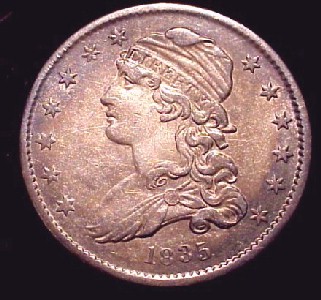 |
“QUARTER MANIA” by Loren Lucason (Member# 97)
I ordered a 1999 proof set from the mint’s web site as well as an extra set of quarters, and, when they became available, a silver 1999 proof set just so I could have the silver quarters. I regularly check the mint’s web site to see when the new quarters and proof quarters will be available. Five different quarters a year of a fifty-quarter history of the United States - who could resist. Quarters are cool.
Being a type collector I decided to build a quarter type set. I combed my collection for quarter types. Thanks to Bill Fivaz I had a nice VF Capped Bust quarter from last year’s Christmas coin auction - a great type quarter. However I had no high grade Barber type quarters or any early key Washington type quarters so I started searching the local coin dealers’ stock. I got all I could afford, including an AU Seated Liberty quarter, a proof Seated Liberty quarter, and two nice VF 1853 A&R Seated Liberty quarters. I‘ve always liked Seated liberty coins - they are so classic.
Then Bill Hamilton brought back an MS60 Barber quarter from Florida, and I bought it - low-grade barbers are everywhere but high-grade barbers are very hard to find. And Frank had a nice white MS62FH 1917 type I Standing Liberty quarter. I got it and had it slabbed. I was visiting Roy’s shop when they finishing the pricing on a new collection he bought. There was an XF capped bust in the collection and when the price was set I had my check in the cash register and the coin logged out of Roy’s stock before Roy had logged it in.
But I couldn’t put a quarter type set together without a Draped Bust
quarter and a G4 1807 quarter, selling for $200 to $300, looked like a
ghost quarter next to the others. A VF Draped Bust quarter, if you
could find one without problems, was selling for $500 to $700 and going
up. So I put in a call to The Gallery Mint Museum. They specialize
in reproductions of very rare coins and the 1796 Draped Bust/Small Eagle
Quarter was a one year type coin so rare that a VF sells for about $10,000.
They made copies of this quarter and sold them for $22. I bought
2 quarters and baked one in tin foil with oregano to take away that ‘made
yesterday’ look. It’s stamped ‘copy’ on the reverse.
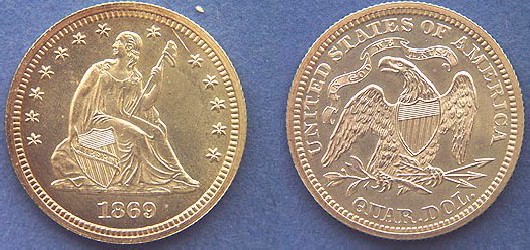 |
Then I went to the foreign coins to find the predecessors of the quarter. I started with the Spanish Pillar 2 Reale. A silver coin struck in Mexico in the 1700‘s; it is said to be the model of the earliest U.S. quarters. Searching World Coin News I found and sent away for a VF pillar quarter. It was well struck and hidden in the devices on the obverse was a small Chinese chop mark - this quarter had traveled! That’s a quarter with history.
The quarter is called ‘2 bits’ referring to one quarter of a Spanish eight-reale cob from the 1600‘s. So I got a 2-reale cob. It is so crude that I may never know for sure if it’s real.
Ferdinand and Isabella were the rulers of Spain when Christopher Columbus
left for America in 1492. They issued a late medieval 1-Reale coin
made of silver that was about the size of a quarter. I found one
advertised in World Coin News. When I called to order it, Tony had
already sold it but had others. So I got the best one from his bunch
and added it to the quarter collection.
 |
In 1893 the U.S. issued its first commemorative quarter. It was in honor of Queen Isabella of Spain. Carl had one that was lightly circulated, a little toned, and had lots of luster. I bought it.
Columbus was financed by the Spanish in the late 1400’s but had come from Italy so I looked into coins from the Italian States of that time period. Genoa was the birthplace of Christopher but Genoese coins were impossible to find. I came across a silver Grosso from another Italian State. It was a high-grade silver coin about the size of a quarter and was struck in the 1400’s. I added it to the quarter collection.
The word dollar comes from the German word Thaler (pronounced taller). So quarter dollar came from quarter thaler therefore I needed a quarter thaler for the quarter collection. But only a few of the German States issued quarter thalers. I checked with Ebay, the coin newspapers, and the dealers until I found a quarter thaler dated 1623 from the German State of Brandenburg. It was somewhat crude but it was uncirculated and it is now in my quarter collection.
In the foreign countries closer to home I came across a lustrous 1853 25-kopek coin from Russia. It was a silver quarter rouble about the size of an American quarter and, since Alaska was part of Russia when it was minted, I bought it and put it in the quarter collection.
Canada, Bahamas, Belize, Netherlands, and the Caribbean States all issued 25-cent coins and I put them in my quarter collection. Mexico, Cuba, and Costa Rica issued 25-centavo coins. They were the right size and metal so I put them into my quarter collection.
Not finding any more quarters I looked into the foreign cousins to the quarter. The French franc, the Spanish peseta, the English schilling, the Venezuelan Bolivar, even a Hungarian korona are all silver coins the size of quarters and I added them all to my quarter collection. The Canadian ’Loon’ dollar is close to the size of a quarter and the English pound is now a coin close to the size of a quarter- I added them to my quarter collection as well.
The Norwegian krone, The Swedish krona, and The Swiss franc have all been quarter size for many years. I have relatives in these countries so I will need to add these quarter-size coins to my quarter collection when I find nice examples.
When I thought I was running out of available quarters I found a quarter Balboa from Panama. Then Milo brought me a 25-cent gambling token from a trip to Europe and Roy had a 25-cent Food Stamp credit token. It took some time to pay it off but I was able get a proof pattern quarter of 1870. That was a quarter I never thought I would own.
The quarter is just the right coin in size and money whereas the silver dollar was too big a size and the cent was too small a money. As well the quarter is large enough for a commemorative. Canada not only issued a set of twelve commemorative province quarters in 1992 (preceding our state quarters by 7 years) they have continued the success of this series with new sets of quarter designs in years since. I have 2 sets of these Canadian quarters hanging on my wall.
Tellers at my bank expect me to ask about quarters when I come in. I have a BU roll of each of the new American quarter designs and I check my pocket change every night to see what new quarters I have picked up - new quarters go into a special jar. Once I needed money to buy a Standing Liberty quarter type coin so I sold 10 rolls of my new quarters to a coin dealer
The other day I was looking at one of my new Maryland quarters and found a die crack through the engraver’s initials on the obverse at the base of Washington’s portrait. At the YN donation auction one of the few coins I got was an error quarter with a cud on the edge from a chipped die. Along with a broad struck quarter and off center quarter I have a good set of quarter errors. I need to make a display holder for them. I have 3 more quarters to go to complete my proof Washington quarter set. I have already designed the custom display holder for it.
I have always liked quarters. I think they are the perfect coin.
There is a great variety quarter types across the world as well as some
great rarities to aspire to here in America. But I would never
get caught up in Quarter Mania. Noo.... Not me……..Loren.
 |
Club Archivist/ Photographer
Robin Sisler
DUES
The Anchorage Coin Club is a non-profit organization formed to provide information, education, and a meeting place for individuals having an interest in numismatics.
Correspondence Address: Anchorage Coin Club, P.O. Box 230169, Anchorage,
Alaska 99523
Return to: "Top of the Newsletter"